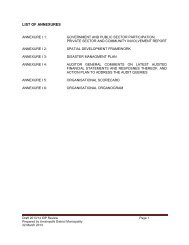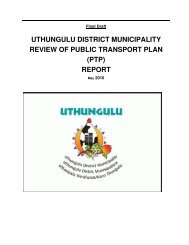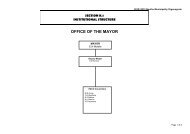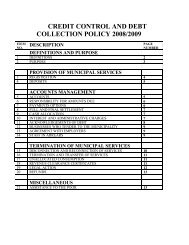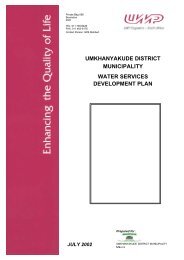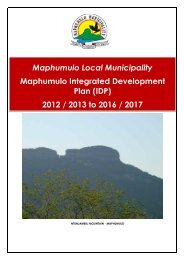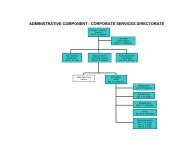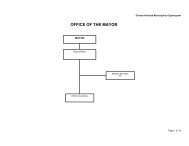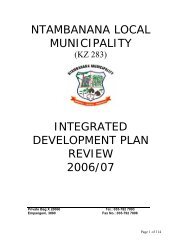Final Adopted IDP - KZN Development Planning
Final Adopted IDP - KZN Development Planning
Final Adopted IDP - KZN Development Planning
Create successful ePaper yourself
Turn your PDF publications into a flip-book with our unique Google optimized e-Paper software.
SOCIAL AND COMMUNITY DEVELOPMENT ANALYSIS<br />
HOUSING<br />
Municipal Housing Demand<br />
The Ulundi Municipality developed its Municipal Housing Sector Plan in April 2006; this<br />
Plan was reviewed and updated in May 2008. According to the information generated by<br />
the Community Survey in 2007, 61.6% of the households within the Municipality reside in<br />
a traditional dwelling, a hut or a structure made of traditional materials while only 27.7%<br />
of households within the Municipality reside in a house or brick structure on a separate<br />
stand or yard. The Municipal Housing Sector Plan defines housing demand within the<br />
Municipality as the number of households requiring formal housing; it is therefore the<br />
intention that formal housing is to replace traditional housing which in turn provides a<br />
clear indication of the extent of the housing backlog that needs to be addressed.<br />
Linking Housing Provision with the <strong>IDP</strong><br />
In the past, the approach followed to addressing the housing backlog was to adopt a<br />
strategy of chasing numbers – a mass housing approach. Through this approach, houses<br />
were built everywhere where land could be acquired cheaply thereby perpetuating urban<br />
sprawl and segregated development areas. Houses were built further from job<br />
opportunities and social amenities, undermining economic viability and environmental<br />
sustainability. Further, the quality of houses was compromised due to poor workmanship<br />
and the lack of integrated quality control approaches.<br />
In its Municipal Housing Sector Plan the Municipality developed a strategy to address<br />
the housing backlog that is premised on the promotion of sustainable development. This<br />
strategy aligns with the policy approach of the Provincial Department of Human<br />
Settlement, which has responsibility for exercising oversight of and providing funding<br />
for housing development projects within the Municipality. What this means is that<br />
housing projects are not stand alone developments but need to inform and be informed<br />
by other developments within the Municipality such as access to health, education,<br />
community, and transport facilities. Other key issues relating to the development of<br />
housing reflected in the <strong>IDP</strong> relate to availability of land for housing development, the<br />
provision of services on proposed housing development sites and accessing funds to<br />
develop the project.<br />
The greatest need for housing is within the town of Ulundi and its peri-urban areas as<br />
well as the emerging settlements of Mpungamhlope, Ceza, Nqulwane, Babanango and<br />
Mahlabathini; the current urban and rural housing projects – completed, in progress and<br />
planned – reflect the priority of providing housing in these areas.<br />
53



